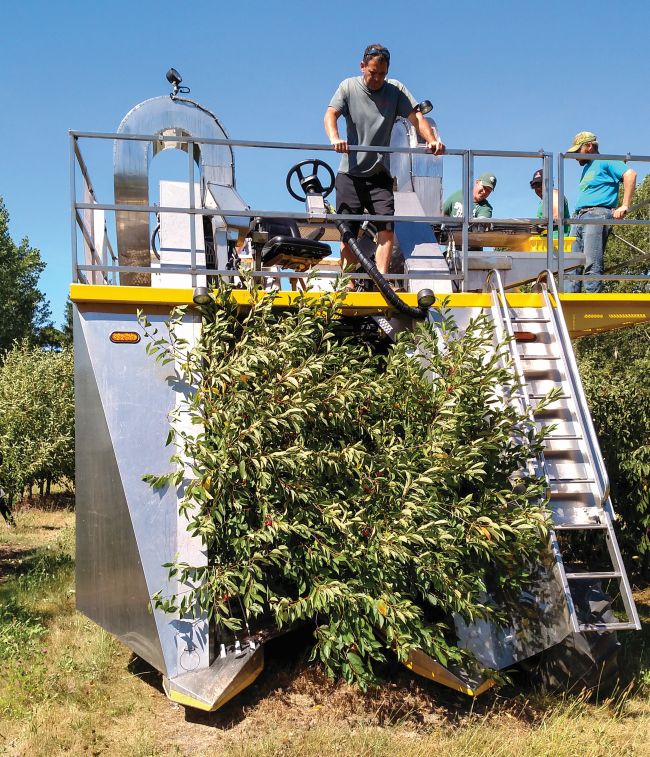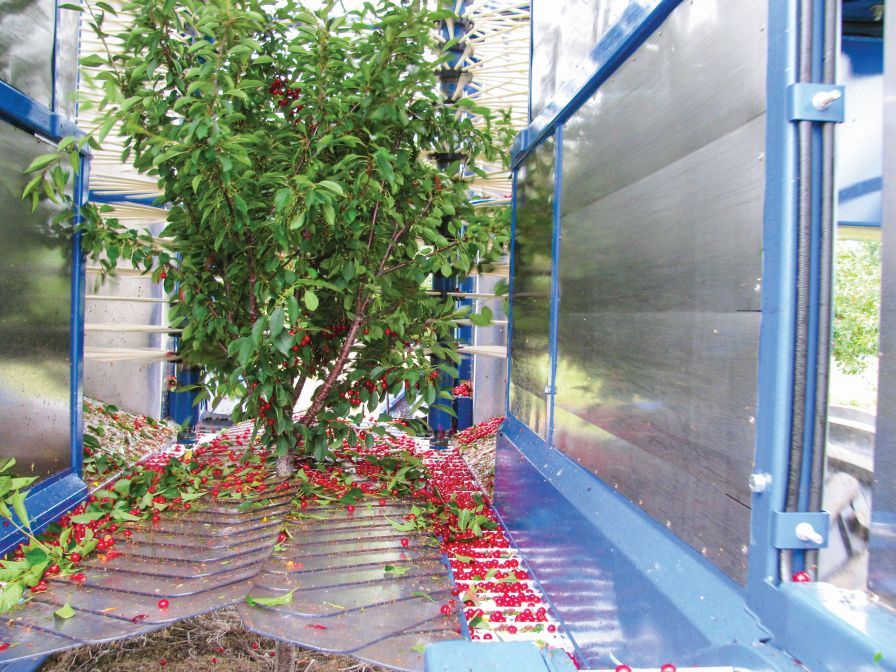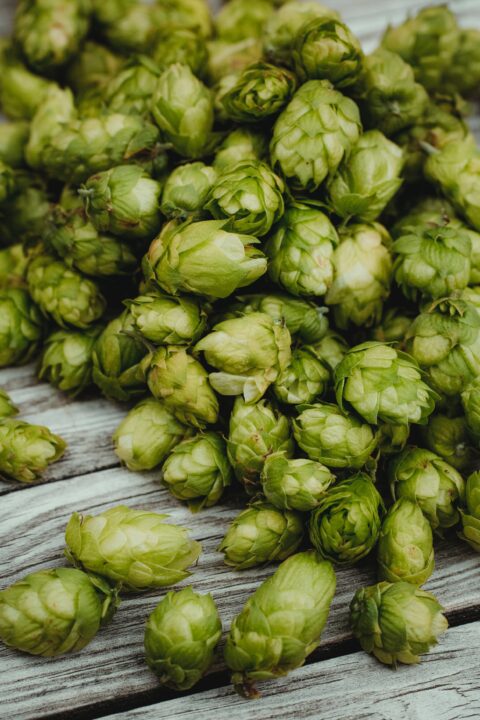Growers Could See Early Returns On Investment With New Harvesting Techniques
Tart cherries are a major crop in Michigan, with the state producing between 70% and 75% of the national supply. Traditionally crops on mature trees are harvested with large shakers. Although trees begin producing fruit in the second or third growing season, growers have to wait a few more years until the tree is able to sustain trunk shaking.

Ron Perry says trees shaken in a traditional orchard will see diminished yields by year 18 and by year 25, growers can see a 50% loss. “Go beyond a 5 second shake and you will see more damage,” Perry says. Larvae of trunk borers can enter the damaged tree and cause it to decline. (Photo credit: Ron Perry, MSU)
But, what if the fruits produced in those early years could be harvested? Early returns on investments are something preached about in other tree fruit commodity circles. What if tart cherry growers could experience such benefits as well?
That’s exactly what Phil Korson, President of the Cherry Marketing Institute, wondered when he visited Poland about 15 years ago and saw cherries being harvested with over-the-row equipment.
“Today it takes about seven years to grow a tree big enough to handle a trunk shaker,” Korson says. “What would it mean to our farmers if we could harvest mechanically at year three? The economics change dramatically.”
So as Ron Perry, Professor of Horticulture at Michigan State University (MSU), returned to research from his stint as department chair, he was encouraged by Korson and others in the tart cherry industry to explore different mechanization options.
Traditional Harvesting
Tree shakers are an expensive investment, which many tart cherry growers already own. There is some hesitation to transition from current growing systems to modern orchard systems. However, efficient as the current system and harvesters are, trees can only sustain so much from shaking before losing production.
Growers also can experience losses due to soft or crushed fruit. One estimate says fruit damage resulted in an average $6 million loss since 1990. Not to mention, growers wait until the tree is strong enough before they can harvest – missing out on early year production.
“Traditional orchards have an 18- to 20-year life span, beyond the sixth growing season on a cherry orchard,” Perry says. “Some orchards will be decimated after 20 years of age and growers will lose more than 50% of the trees.”
Economic viability is something those in the tart cherry industry are increasingly examining. The focus is on how to prevent fruit damage and get early returns, which is where high-density orchards and mechanical over-the-row harvesters enter the equation.
“The return on investment should be much quicker because we will harvest fruit at a much younger age,” Korson says.

Rob Kolesar of Spring Brook Supply operates a Littau ORXL on a cherry block in 2015 at the Northwest Michigan Horticultural Research Center in Traverse City, MI. Spring Brook Supply is a Littau distributor in Southhaven, MI. (Photo credit: Ron Perry, MSU)
There are costs with moving to a high-density orchard, Perry says. In traditional systems, trees are planted 15 feet apart, and a new high-density planting will mean more trees per acre. Growers with a double-incline harvester would be able to make the switch to a high-density system much easier, Perry says. However, the end goal of high-density orchards is to get returns in the third leaf and payback much quicker.
Over-The-Row Harvesters
Perry and his research team began trialing berry harvesters with rotary tines at the recommendation of researchers in Serbia and Poland.
Perry’s team demoed an Oxbo 7264 in 2008, an Oxbo 9000 in 2009, a BEI 3000 in 2010, and a Littau ORXL harvester in 2015. Perry says they are still studying which systems work best for the rotary tine harvesters. With only five years into the project there is still a lot Perry and his research team has to learn.
However, there are two different approaches being examined closely: tall spindle, high-density systems and a low bush hedge canopy to fit current rotary tine berry harvesters. Tall trees will not work with the current rotary tine berry harvesters available.
“So far we have found that we can harvest a tree no taller than 13 feet and no wider than 10 to 11 feet as long as branches are limber,”
Perry says. ““We’d probably need to keep the tree small and in bush form.”
For now, Perry feels this is the best path forward with the current rotary tine berry harvesters. He says the tunnel dimensions for which the trees pass through is 4-feet-by-8-feet.

Tart cherries in a 4 -year-old Montmorency traditionally grown block fall on the catch leaves of the Oxbo 9000 used at Wright Orchard near Belding, MI, in 2009. (Photo credits: Ron Perry, MSU)
How The Harvester Works
Perry and his research team run the harvester at approximately 1.5 mph, and fill one cooling tank per row 500 foot row with young trees. Perry said the speed is much faster than the double incline shake and harvest system and naturally faster than hand harvesting.
“I harvested about one acre of tart cherries in a 4-year-old conventional orchard with the berry harvester once in about 30 minutes. The grower told me that if you put hand labor in the same block, that would have taken a crew of 5 to 6 people about 3 to 4 days to do the same thing,” Perry says.
Fruit retention in 2015 averaged between 500 to 600 grams, which is much higher than the commercial recommendation of 150 to 300 grams. Fruit was removed without damage or very little damage to the canopy. In the fifth growing season, they were able to get 14 to 16 pounds per young Montmorency tree with a 65% crop (due to a spring frost). Perry says he thinks they can get 20 pounds per tree.
“The rotary tine harvester is fantastic at removing fruit with minimal canopy and trunk damage. All fruit is removed with little behind and we don’t have to use a fruit abscising inducing compound like Ethephon,” Perry says.
In recent findings, Perry has calculated that for a planting at 670 trees per acre, depending on canopy treatment, cumulative yield per acre for Montmorency in years 4 and 5 totaled 13,000 to 23,000 pounds per acre. This crop would not have been harvested in these years in a traditional orchard.
The Next Steps
Perry says his research team will be looking at the impact the berry harvester has on fruit quality when compared to a traditional system. The idea is fruit removed with a rotary tine harvester has a shorter distance to fall, therefore likely reducing the number of soft fruit.
“Fruit is basically dropping from 4 or 5 feet instead of 18 feet,” he says.
Perry also says it is important to measure the impact of summer pruning and root pruning so that he will be able to develop a standard protocol.
“Root pruning and summer hedging (used independently) can reduce canopy volume by at least 30% without reducing yield compared to control and in root pruning only fruit size was reduced by about 10%,” he says.
He’s also testing the rootstock combinations and 5 varieties to see how these trees fit the necessary canopy structure to accommodate the berry harvesters. Montmorency, a processing standard, can be very vigorous and grows like a bush. But, on a dwarfing rootstock, it is more likely to fit the over-the-row harvester.
The goal of this project, according to Korson, is to ensure the Michigan tart cherry industry remains competitive. Perry also sees this project as an opportunity to expand the tart cherry market whether that is juice and wineries or for processing.
“It is exactly what we need to be doing as an industry. Testing new systems, varieties, equipment, and rootstocks will reduce the risks for growers down the road,” Korson says. “Can we develop a harvest system that minimizes the drop when fruit is harvested and eliminate soft fruit in the future which would increase quality and decrease pit counts in finished product?”
He is always encouraged by the grower interest and support for this project by the attendance at field days and tours.
“It gives us options in planting specific varieties for specific uses. We can bring them into production quicker and deliver to the market higher quality fruit,” he says.










